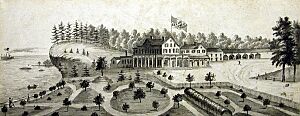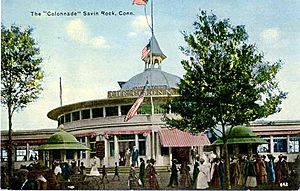History of West Haven, Connecticut facts for kids
West Haven, Connecticut, is a city with a long and interesting past! This article will tell you all about its history, from when Native Americans lived there to its time as a busy port and a fun amusement park. You'll learn about how it became a city and some of the important things that happened there.
Contents
Early Days and the American Revolution
Long ago, Native American tribes like the Quinnipiac, Pequot, and Mohegan spent their summers near what is now West Haven. They enjoyed the area around the West Haven green and Morse Park, and even further inland near Maltby Lakes. In 1614, a Dutch trader named Adriaen Block explored the coastline. He noticed many large piles of oyster shells, showing that Native Americans had lived there for a long time.
In 1638, about 500 settlers, led by Reverend John Davenport, came from the Massachusetts Bay Colony and started the New Haven settlement. Just ten years later, in 1648, West Haven was settled. Back then, it was known as West Farms and was part of the original New Haven Colony. There's even a special painting from 1938 called "Fording of the West River to Settle West Haven." It shows how early settlers crossed the West River using a horse bridge.
The colonists built a Congregational meeting house, which was a central place for town records, government meetings, and events. It also held the first public library in Connecticut! In the early 1700s, they also built Christ Episcopal Church, which was one of the first Episcopal churches in New England. Yale College helped start this church, and it was built right next to the meeting house.
In 1719, West Haven officially separated from the Orange parish and became its own hamlet.
West Haven During the Revolution
In 1779, during the American Revolution, British soldiers attacked New Haven Harbor and landed in West Haven. A brave militiaman named Thomas Painter was watching for British ships from atop Savin Rock. He is so important that his image is on the city's official seal!
The main street in West Haven, Campbell Avenue, is named after a British officer, Adjutant William Campbell. He is remembered for helping a wounded minister, saving him from being killed. Campbell supposedly said, "We make war on soldiers, not civilians." Sadly, Campbell himself was killed later that day, on July 5, 1779, on Allingtown Hill. He is buried in the Allingtown part of West Haven.
West Haven's Economy and Jobs
| West Haven's Population |
|
| 1930 | 25,808 |
| 1940 | 30,021 |
| 1950 | 32,010 |
| 1960 | 43,002 |
| 1970 | 52,851 |
| 1980 | 53,184 |
| 1990 | 54,021 |
| 2000 | 52,360 |
| 2002 | 52,733 (est.)] |
For a long time, from the early colonial days until after World War II, West Haven was a very busy place for shipping. Ships built in West Haven sailed to places like the West Indies and South America. They would bring back exciting goods like spices, silks, rum, and sugar. In return, they would trade local timber. More than 35 ship owners, builders, and captains from West Haven were part of this important trade.
Scandinavian boat builders in town were known for building tall-masted trade ships. During World War II, West Haven continued its shipbuilding tradition. Workers built pontoon crafts and lightweight Chris Craft boats for the military.
Factories also played a big role in West Haven's economy. The West Haven and American Buckle Shops made buckles, buttons, clips, and braces during the American Civil War. Later, companies that made pianos and organs also opened in the city. During World War II, the Armstrong Rubber Company made tires and rafts for the military, helping the war effort.
Savin Rock Park: A Fun Place to Visit
Savin Rock became a very popular vacation spot by the 1870s. It was easy to get to, with ferries and horse-drawn cars bringing people from New Haven. This beachside resort on New Haven Harbor had a playground and a carousel, making it a favorite place for families.
Savin Rock Amusement Park was very popular in the 1940s and 1950s. It was a lively place filled with rides, games, and fun. However, the park eventually closed in the 1960s. Today, one of the last reminders of the area's fun past is Jimmies of Savin Rock. This famous restaurant is known for its delicious seafood and unique split hot dogs.
West Haven in the 20th Century
In the early 1900s, West Haven and North Milford were joined together as part of the town of Orange. But in 1921, West Haven decided to become its own separate town. Later, in 1961, it officially became a city. Because of this, West Haven is often called "Connecticut's Youngest City."
A famous food company started in West Haven in 1927. Lender's Beigel Bakery was founded by Harry Lender, an immigrant from Poland. At first, he mainly sold his bagels to Jewish delicatessens in New York City. His sons, Murray and Marvin, later took over the business. They became famous for their "flash-frozen" bagels, which meant bagels could be sold all over the country! By 1984, the business had grown to 600 employees before it was sold to Kraft Foods.
West Haven has a mayor-City Council form of government. This means the city is led by a mayor and a group of elected officials called the City Council. For example, John M. Picard was elected as the city's tenth mayor in 2005. The city also has three separate fire districts, each with its own fire department: West Haven, West Shore, and Allingtown.



